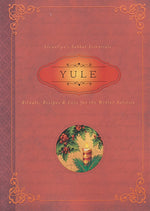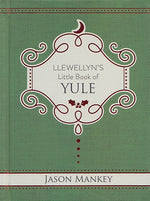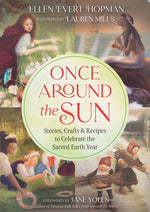© Copyright 2023 Karen Charboneau-Harrison, All Rights Reserved.
The Winter Solstice holidays are the perfect time to share the magic and mystery of Pagan spirituality with your children and to show them how to weave all of the world celebrations and religious traditions of the season together. Why not celebrate the rebirth of the Sun and honor the spiritual customs of all of your friends and family throughout the month of December? After all, doesn’t it say in the Charge of the Goddess “all acts of love and pleasure are my rituals”? Getting together with loved ones to share joy, family and the lengthening light of the Sun certainly qualify as acts of love and pleasure. You don’t have to invite Aunt Matilda to your circle – just join in all the parties and gatherings with love in your heart while knowing that each custom followed is based on ancient practices and fascinating lore.
Like so many celebrations that have their origins with our ancestors, the lore and legend of the Yule season is rich and varied. Select the stories you like best to share with your children at this time and take every opportunity to explore with them the history of each of the symbols of this holiday season.
The decorated Christmas Tree as we know it today seems to have begun in Germany in the 7th century with full-fledged decorating of outdoor trees with ribbons and candles. It seems that trees were brought indoors to decorate for the holiday beginning in the 17th century. Prior to this time it was customary to bring cuttings from evergreen plants (holly, rosemary, pine boughs, etc) inside to decorate and scent the home while reminding ourselves of the light and life just around the corner as the Wheel of the Year progresses toward Spring.
While most of us burn wood in a fireplace for warmth and emotional comfort during the Yule season, our ancestors burned the Yule Log on solstice night to encourage the Sun to gain in strength. The Yule-log custom is widespread in Europe and was brought to some communities and homes in North America. A huge oak or pine log was hauled into the house at the beginning of the Yule season and kindled in the belief that the fire would protect the inhabitants of the house from lightning, fires and sickness. During the rest of the year a piece was kept under a bed to continue the protection. The piece was also dipped in water which was then sprinkled into the cattle’s water to help them calve and keep them healthy through the coming year. The next year’s Yule log was lit from a piece of the last year’s Yule log and the ashes kept to be mixed in with the spring seed to promote growth. Traditionally, writing one’s wishes on a piece of paper and burning it with the Yule log on Solstice Eve makes them come true.
Another name for Santa Claus is Kris Kringle and comes from the Norse traditions. Kris Kringle (Christ of the Wheel) is the title of the Norse god born at Winter Solstice. It is thought that Santa is also derivative from the Norse sky God, Odin. During the Yule season’s stormy, cold nights, Odin rides his eight-footed white horse throughout the world bestowing gifts on worthy people and dispensing justice to the transgressors. Santa Claus may have originally evolved from legends of Odin riding a white horse across the sky, but his jolly image today in red and white actually comes from a Coca-Cola ad campaign from the 1930’s in the United States.
The association of the Christ-child with the births of sacred children is obvious: Dionysus laying in His crèche lined with wheat and a nimbus (halo) around his head; Mithras’s miraculous birth from a sacred stone on December 25th; Mabon, the sacred son of Modron, who restores balance to the world.
While your children may be too young to share your Solstice ceremony, there are many things to do with them that the whole family will enjoy. Decorating your home is one of the most fun – just take the time to explain each object that you are using and its significance. Yule celebrates the rebirth of the Sun child and focuses on sending out energy to ensure that this rebirth occurs and life continues. Most modern Christmas customs are modified old Pagan customs. Decorating one’s home with evergreen plants symbolizes undying life and the optimism that life will return after winter’s harshness. Our ancestors believed that by decorating with evergreen plants such as holly, ivy and mistletoe that they were helping to bring the Sun through a dangerous time of diminished light. Holly represents death and rebirth and is sacred to Mother Holle, a Scandinavian goddess of death and regeneration. Its white flowers symbolize death and purification, the red berries rebirth and physical life and the deep green leaves everlasting life.
Mistletoe, well-known as sacred to the Druids, was used to protect and ward off negativity when hung above windows and doors. Our ancestors venerated mistletoe because it grows upon the sacred oak and remains green in winter when the oak is bare of leaves. It was thought that the mistletoe guarded the oak’s soul during winter’s harshness. The custom of kissing beneath the mistletoe came from the idea that the mistletoe is the regenerative force of the God and, when one kisses another beneath it, one is wishing life and luck for one’s partner.
As you decorate your home with sprigs of holly and mistletoe, let your children know how the energy of these plants brings new life and protection into your home (and be sure to let them know NOT to eat the mistletoe berries!). Choose your tree decorations with intention – the strands of lights to help bring back the sun to full strength; the star at the top to represent the Pentagram (the four Elements with Spirit overseeing all manifestation); strings of popcorn (corn, of course, symbolizes the God) and cranberries to bless and later feed the birds (no salt on the popcorn, please); elf and fairy decorations to ask them to celebrate the season with us and bless our homes. Did you know that there is a Ukranian legend that a farmwoman found a spider in her Christmas tree and decided to let it stay there in the warmth for the night? The next morning she awoke to discover that the spider had spun lovely webs throughout the tree during the night and the webs had turned to sterling silver.
The customs of this season are numerous and encircle our globe. This article is just the tip of the iceberg! Here are a few more ideas for you to use in your celebrations with your children:
- Cut out snowflakes
- Make your own gifts for each other
- Tell stories about the sacred Sun child.
- Sing seasonal songs such as “Deck the Halls” and modify other traditional songs such as “Silent Night” to sing with your children.
- Have a happy, prosperous and healthy Solstice!
| Recommended Products | |
 Yule Yule |
 Llewellyn's Little Book of Yule Llewellyn's Little Book of Yule |
 Old Magic of Christmas Old Magic of Christmas |
 Once Around the Sun Once Around the Sun |
